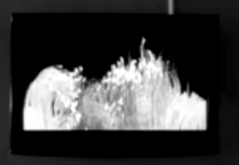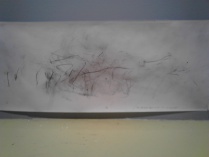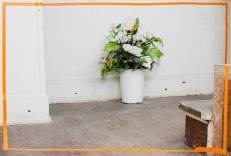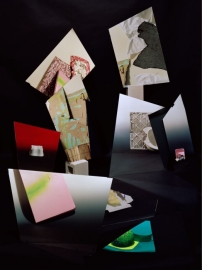by Jessica Santone
At first glance, the works in Lee Blalock’s Neue exhibit are somewhat opaque: sculpted hands manipulating the exposed mechanisms of music boxes, tiny speakers, sculptures of folded sheets of paper, papers of the sheet music used by music boxes, and abstract chalk drawings. The work occupies more peripheral gallery space in the Hyde Park Art Center, principally within a hallway and along the floor upstairs. This suits the subject matter, which might be described as an emergent formalism or as the artist puts it in her statement, a desire to “find a new vocabulary for the ‘future’ body.”[1] Blalock’s ‘future’ body arises from traces of activity that are mechanical, programmed, rhythmic, and controlled. With the exception of the sculpted hands and fragmented or abstracted body parts in several videos in the exhibition, there are no bodies represented in the exhibit. The ‘future’ body has yet to fully materialize. Based on the number of works presented in series, it appears that this body will emerge through repetition. That is, it is a performative body.
Blalock’s techno-futurist work points at once to the future and to the past. Grounded in systems of abstraction that have ancient origins – mathematics, music, dance – her work aims to locate new gestures and forms. Indexing Blalock’s own body, which is already a palimpsest of learned, rehearsed, and culturally coded gestures, the artworks here build a ‘future’ from lived experience within materiality. Her ambition to move the body beyond the strictures of identity or politics through recourse to abstraction is idealistic – though these noble efforts are nonetheless strikingly beautiful. This is especially true of works that most clearly involve performative elements.
 For example, in Chalk In Mvmts (2013), a video accompanied by an installation series, Chalk for a Quartet (2013), the artist repeats the motions of writing with chalk on a chalkboard, wiping the residue of the chalk on her clothing. The video, which is more strongly aural than visual, incongruously pans across or pauses on still images of chalk while the sounds of writing pace steadily along. The sounds of the chalk are clean and rough. The chalk must be soft enough, since it does not scratch the board. The motions must be simple enough, since they sound mechanical. The resulting visual objects are messy, with chalk lines densely overlapping into a velvety blur. This work more vividly recalls the excessively repetitive writing exercises of Hanne Darboven. Darboven’s texts were less layered, but equally obscured the intelligibility of her systematized order through the gesture of handwriting. Like Darboven and her peers of the 1970s and 1980s (one might think of Carolee Schneemann’s messier Up To And Including Her Limits (1973) as another example), Blalock is interested in bodily traces, recording, and iterative structures.
For example, in Chalk In Mvmts (2013), a video accompanied by an installation series, Chalk for a Quartet (2013), the artist repeats the motions of writing with chalk on a chalkboard, wiping the residue of the chalk on her clothing. The video, which is more strongly aural than visual, incongruously pans across or pauses on still images of chalk while the sounds of writing pace steadily along. The sounds of the chalk are clean and rough. The chalk must be soft enough, since it does not scratch the board. The motions must be simple enough, since they sound mechanical. The resulting visual objects are messy, with chalk lines densely overlapping into a velvety blur. This work more vividly recalls the excessively repetitive writing exercises of Hanne Darboven. Darboven’s texts were less layered, but equally obscured the intelligibility of her systematized order through the gesture of handwriting. Like Darboven and her peers of the 1970s and 1980s (one might think of Carolee Schneemann’s messier Up To And Including Her Limits (1973) as another example), Blalock is interested in bodily traces, recording, and iterative structures.
 Other drawings hung adjacent to these on the wall are also performative. Messy abstract drawings lacking the orderliness of the graphical digital prints on the opposite wall, these drawings gain in meaning when their materials are exposed: “made with prosthetics attached to the body.” Amending the body in this manner, Blalock produces performative drawings that show a more complex, cyborg organism at work. She produces traces of a bodily collaboration with a non-bodily component; a new kind of bodily trace results. While the digital prints present abstraction as information density, in the manner of Julie Mehretu, these drawings give an abstraction that is biological, resulting from a failure to fully cohere with the prosthesis. Interestingly, both are cases of a synthesis of body and machine, and both turn to abstraction to avoid the conscriptions on cultural identity.[2]
Other drawings hung adjacent to these on the wall are also performative. Messy abstract drawings lacking the orderliness of the graphical digital prints on the opposite wall, these drawings gain in meaning when their materials are exposed: “made with prosthetics attached to the body.” Amending the body in this manner, Blalock produces performative drawings that show a more complex, cyborg organism at work. She produces traces of a bodily collaboration with a non-bodily component; a new kind of bodily trace results. While the digital prints present abstraction as information density, in the manner of Julie Mehretu, these drawings give an abstraction that is biological, resulting from a failure to fully cohere with the prosthesis. Interestingly, both are cases of a synthesis of body and machine, and both turn to abstraction to avoid the conscriptions on cultural identity.[2]
 The most outstanding work in the exhibition comes at the end of the hall, tucked away in a black box room: Stereo Test No. 1 (2013). In this six-minute video, appropriately playing on a loop, the artist conducts a series of exercises to test presumably her own body. In the voiceover, we are told that the movement exercises will show how a body may be designed for efficiency and sculpted in a new way. The language is reminiscent of other techno-futurist design manifestos, both recent and historical, from Modernist designer Le Corbusier[3] to Post-Modernist architect Greg Lynn or contemporary designer Andrea Zittel. The dancing body moving mechanically and cold voice over convey a tone of scientific marketing meanwhile. New modifications and designs will enhance and improve for a better you! But the presentation of the video and its title suggest that something else is at work here as well. Stereo Test No. 1 is ‘in stereo’ not for the performing body who appears recorded doubly, does not speak, and disintegrates into pixels at the end of the video. Rather, it is in stereo for the viewer, for the listener. If the objective in Neue is to produce a ‘future body’ that moves beyond identity, then it is not only that body that must be trained and programmed to perform in new ways. The bodies of the new body’s spectators must be reprogrammed as well so that they encounter the other synthetically, mathematically, abstractly, and not essentially or intrinsically. Whether or not this can be accomplished with an instructional video that alternates its focus from the left to the right, visually and then aurally, the goal to design a new public is clearly at issue.
The most outstanding work in the exhibition comes at the end of the hall, tucked away in a black box room: Stereo Test No. 1 (2013). In this six-minute video, appropriately playing on a loop, the artist conducts a series of exercises to test presumably her own body. In the voiceover, we are told that the movement exercises will show how a body may be designed for efficiency and sculpted in a new way. The language is reminiscent of other techno-futurist design manifestos, both recent and historical, from Modernist designer Le Corbusier[3] to Post-Modernist architect Greg Lynn or contemporary designer Andrea Zittel. The dancing body moving mechanically and cold voice over convey a tone of scientific marketing meanwhile. New modifications and designs will enhance and improve for a better you! But the presentation of the video and its title suggest that something else is at work here as well. Stereo Test No. 1 is ‘in stereo’ not for the performing body who appears recorded doubly, does not speak, and disintegrates into pixels at the end of the video. Rather, it is in stereo for the viewer, for the listener. If the objective in Neue is to produce a ‘future body’ that moves beyond identity, then it is not only that body that must be trained and programmed to perform in new ways. The bodies of the new body’s spectators must be reprogrammed as well so that they encounter the other synthetically, mathematically, abstractly, and not essentially or intrinsically. Whether or not this can be accomplished with an instructional video that alternates its focus from the left to the right, visually and then aurally, the goal to design a new public is clearly at issue.
[1] Lee Blalock, Artist Statement, http://www.leeblalock.com/main.html.
[2] Lawrence Chua, “Interview with Julie Mehretu,” BOMB 91 (Spring 2005): http://bombsite.com/issues/91/articles/2714.
[3] See: Le Corbusier, Towards a New Architecture [1923], excerpted in: Ulrich Conrads, Programs and Manifestos on 20th-century Architecture, 59-62 (Cambridge, Mass.: The MIT Press, 1971). Available at: http://www.gwu.edu/~art/Temporary_SL/177/pdfs/Corbu.pdf.


